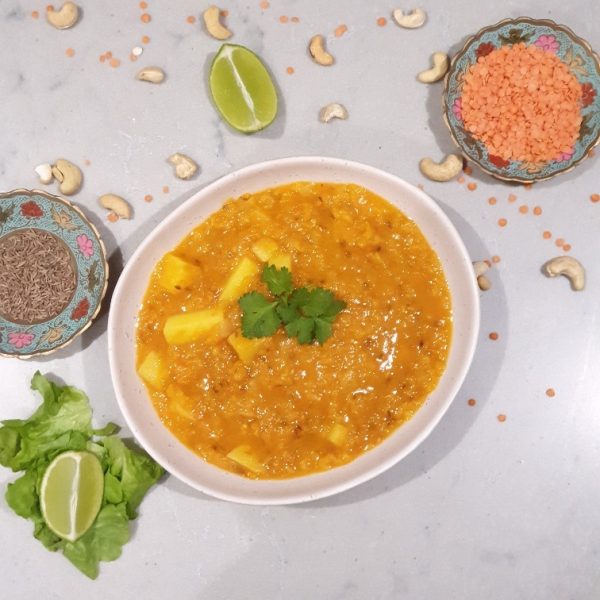
This is the very first Indian dish I learned to cook! My love for Indian cuisine was a slow burn, not love at first sight. Growing up in a traditional Italian family, the flavours I was familiar with included tomato, basil, rosemary, and parmesan cheese. Exotic spices and heat were entirely new to me.
When I met my husband, who is Indian, 26 years ago and had dinner at his family home for the first time, it was a cultural shock. It took some time to adjust my palate, but eventually, I began to appreciate and enjoy the complex flavours. This dhal recipe was the first Indian dish I truly enjoyed because it was mild in terms of spices, and the coconut cream added a rich, creamy texture that softened the intensity of the flavours.
Now, this dish is on repeat in our home. I love making it with extra vegetables—in this case, broccoli. It’s also great with potatoes and zucchini. When I crave something lighter, I prepare it without the coconut cream, making it subtle yet still nourishing. This recipe represents a beautiful fusion of my Italian roots and the Indian flavours I’ve grown to love.
Orange lentils are a nutritional powerhouse, containing about 25 grams of protein per 100 grams, which makes them an excellent source of plant-based protein. This high protein content supports muscle repair and growth, making lentils a great addition to vegetarian and vegan diets. In addition to protein, orange lentils are rich in essential nutrients such as iron, which is vital for transporting oxygen in the blood, and folate, which is important for cells repair.
Before cooking, it’s important to rinse lentils thoroughly until the water runs clear. This process helps remove any dirt, or impurities that may be present on the lentils, ensuring a cleaner taste and better texture in the final dish. Rinsing also helps reduce the foaming that sometimes occurs during cooking.
In terms of serving suggestions, this dish pairs with various accompaniments. Basmati rice is a classic choice, providing a fragrant and fluffy base that complements the rich flavours of the dhal. Alternatively, Roti or Naan bread can be served alongside to scoop up the dhal, adding a delightful texture contrast. For a more complete meal, consider adding a side of pickles or a fresh salad to balance the richness of the dhal and enhance the overall dining experience.
The process of learning and perfecting this dish has deepened my appreciation for the diversity in food and has become a beloved staple in our family meals. Each time I cook it, I am reminded of the cultural blending and the personal growth that came with embracing new cooking traditions.
Cooking this dish has not only been a way to explore new flavours but also a way to connect with my husband’s culture. The process of preparing dhal has become a moment of blending our backgrounds and creating something unique together. Sharing this meal with our family and friends has brought us closer.
To create a richer version of this dhal substitute one cup of water for coconut milk. And add the coconut milk about 10 minutes into the cooking process. Enjoy!
Absolutely not, the recipe is the classic version without it but you can definitely add it in.
Zucchini cut up into small pieces works well. Or add broccoli or cauliflower florets. If using broccoli add this towards the end of the cooking process so they remain a bit firm. Cauliflower can be added in early as it takes longer to cook than broccoli.
Sure, at any Indian store you will find yellow dhal, mung dhal, and lots of similar small dhals. Orange is used mostly as it’s the easiest to find in conventional supermarkets and usually the quickest to cook. If using different lentils you may need to keep an eye on the cooking process and add more water.
No, for a classic version, simply use lentils and no other vegetables.
Yes, store in an airtight container, preferably glass. I don’t recommend freezing the version with potato. Potatoes don’t freeze so well.
Yes, you can reduce the amount of cumin seeds and turmeric or leave them out entirely for a more subtle version
If you don’t have passata, you can use canned crushed tomatoes or fresh tomatoes, diced as a substitute. Both will work well to create the base of the dish. The fresher the tomato the lighter the overall result will be, but equally delicious.